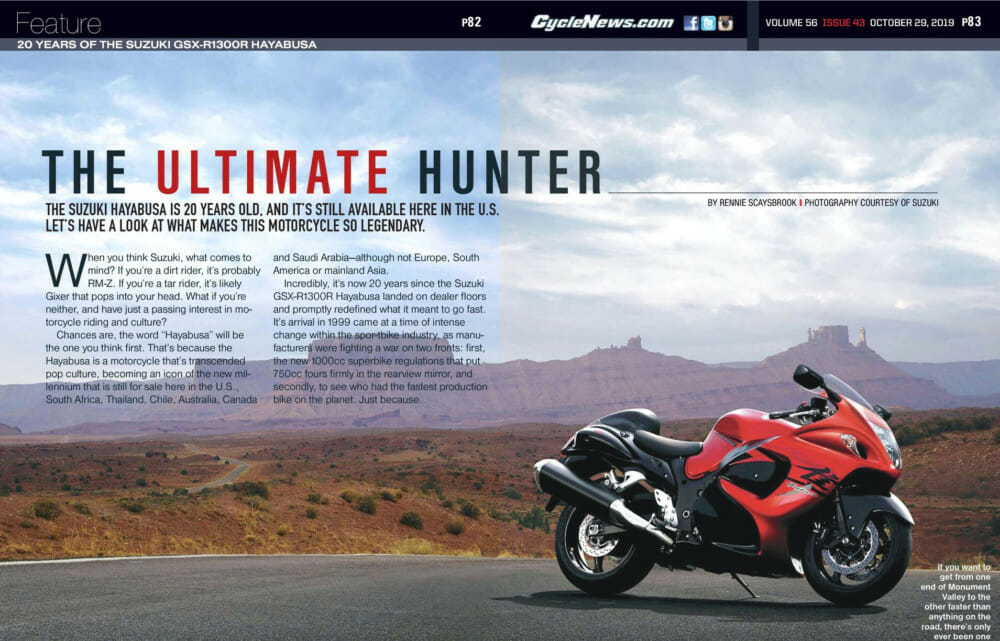Rennie Scaysbrook | October 31, 2019
The Suzuki Hayabusa is 20 years old, and it’s still on sale here in the U.S. Let’s have a look at what makes this motorcycle so legendary.
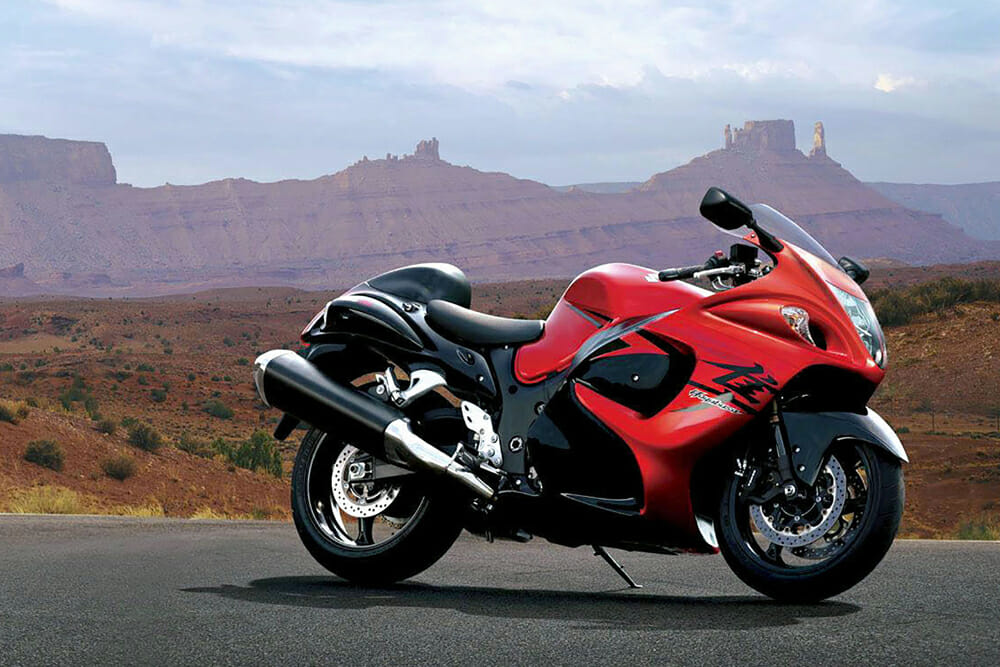 If you want to get from one end of Monument Valley to the other faster than anything on the road, there’s only ever been one choice.
If you want to get from one end of Monument Valley to the other faster than anything on the road, there’s only ever been one choice.
When you think Suzuki, what comes to mind? If you’re a dirt rider, it’s probably RM-Z. If you’re a tar rider, it’s likely Gixer that pops into your head. What if you’re neither, and have just a passing interest in motorcycle riding and culture?
Chances are, the word “Hayabusa” will be the one you think first. That’s because the Hayabusa is a motorcycle that’s transcended pop culture, becoming an icon of the new millennium that is still on sale here in the U.S., South Africa, Thailand, Chile, Australia, Canada, and Saudi Arabia—although not Europe, South America or mainland Asia.
Incredibly, it’s now 20 years since the Suzuki GSX-R1300R Hayabusa landed on dealer floors and promptly redefined what it meant to go fast. Its arrival in 1999 came at a time of intense change within the sportbike industry, as manufacturers were fighting a war on two fronts: first, the new 1000cc superbike regulations that put 750cc fours firmly in the rearview mirror, and secondly, to see who had the fastest production bike on the planet. Just because.
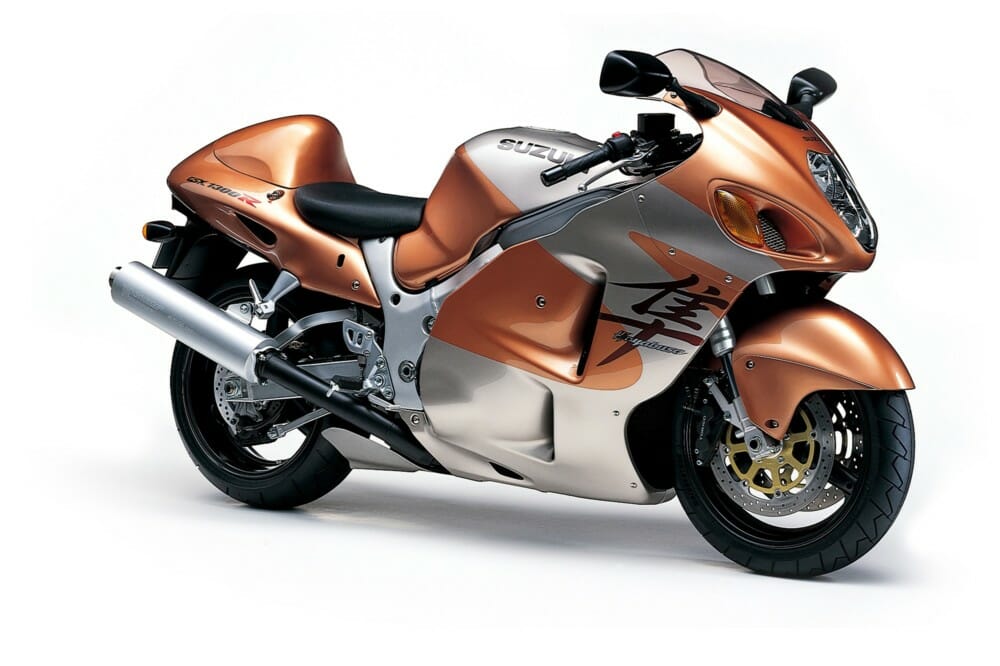 The original Suzuki GSX-R1300R Hayabusa is as much a landmark as the original Katana. Maybe more so.
The original Suzuki GSX-R1300R Hayabusa is as much a landmark as the original Katana. Maybe more so.
For the U.S. media, the Hayabusa was launched at Circuit de Barcelona-Catalunya, 10 miles out of downtown Barcelona. We sent now Cycle World editor, but then Cycle News monkey, Mark Hoyer, to the intro. And this is what he said: “The end of the trip was marked with disbelief. Disbelief that a street motorcycle running on pump gas is capable of such performance, and disbelief that we actually sampled it in traffic with steel guard rails flying past at 180 mph, our helmet’s chinbar smashed up against our faces. Disbelief that for $10,499, you can walk into a Suzuki dealership and buy this motorcycle. Amazing.”
At the end of 1998, it was not Suzuki but arch-rival Honda that held the crown of the fastest production street bike. The CBR1100XX Super Blackbird arrived a couple of years earlier in 1996 and displaced the Kawasaki ZZR-1100 from the top-speed perch, moving the mark from 170 mph to 180 mph on a good day. Suzuki, a diminutive company when compared to the colossus that is the Honda Motor Company and Kawasaki Heavy Industries, wanted to embarrass its counterparts and show just what was possible with a four-cylinder motor with zero regards to any sort of rulebook.
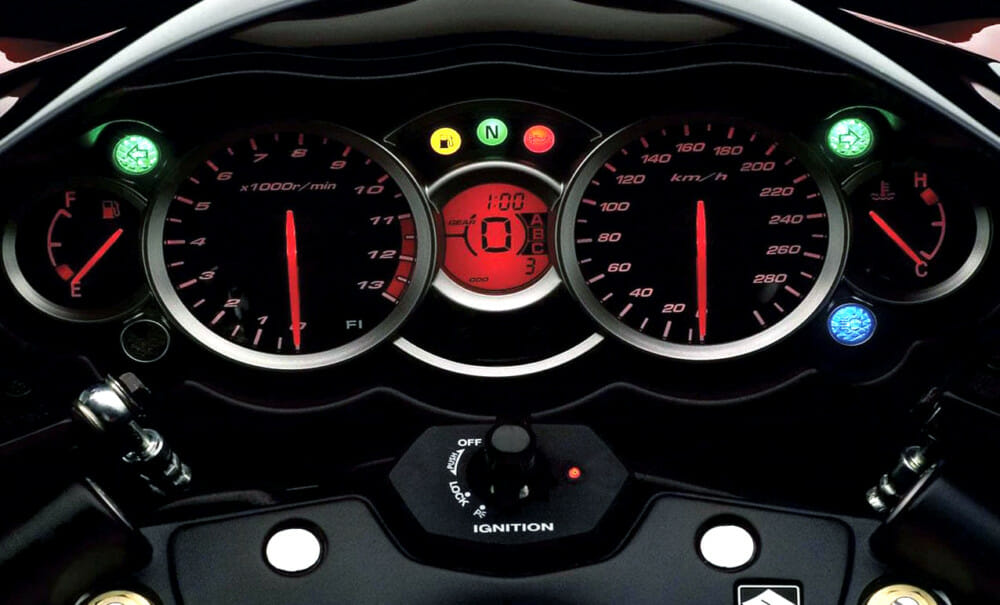 A gear-position indicator is the only digital piece in a sea of glorious analog tachos.
A gear-position indicator is the only digital piece in a sea of glorious analog tachos.
The Hayabusa’s goal was not just top-speed domination, but to redefine what a luxury sport touring (with a firm emphasis on sport) could be. At the time of its 1999 release, the motorcycling public was going gaga with the possibility of a standard production motorcycle that could hit the magic 200.
There’s no record of a standard 1999 Hayabusa hitting that 200-mph mark, with most reports indicating about 190-195 mph, depending on conditions. That was still a considerable distance from the Blackbird and made Kawasaki instant also-rans.
Suzuki achieved the top-speed increase with a combination of slippery wind-tunnel designed bodywork, ram-air induction, and good old-fashioned cubes, coming to the top-speed gunfight with 1298cc bazooka with a claimed 175 horsepower compared to the 145 horsepower/1052cc Kawasaki and the 162 horsepower/1137cc Honda.
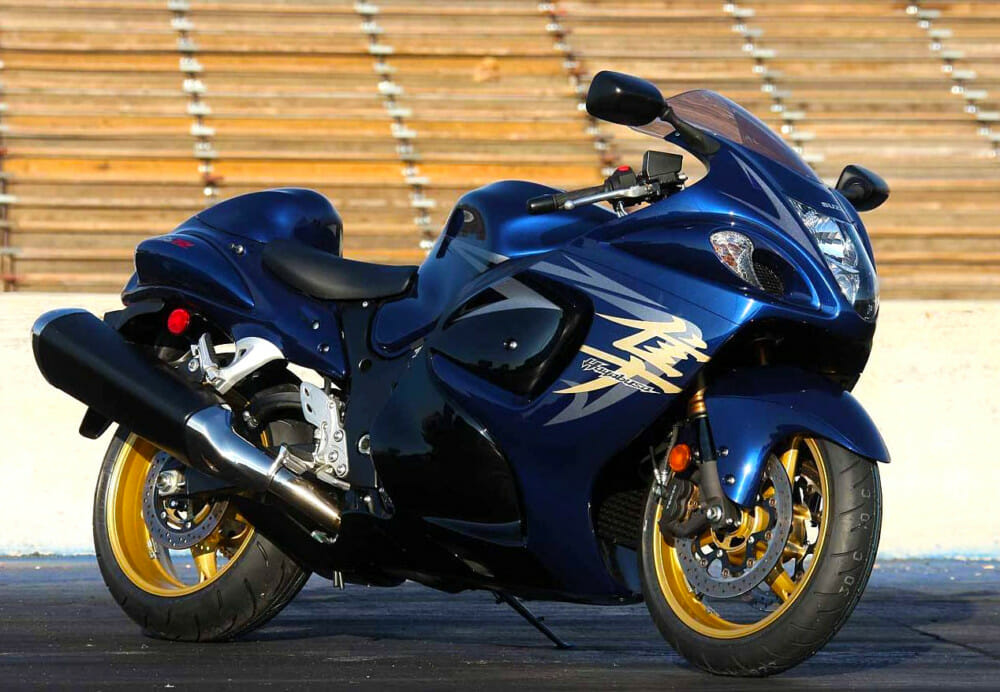 The 2008 Hayabusa saw the only major update in the model’s history.
The 2008 Hayabusa saw the only major update in the model’s history.
It was a battle that won before its time, as the Japanese manufacturers got together one year later in 2000 and put in place a gentleman’s agreement that no production motorcycle would exceed 300 km/h (186 mph). That agreement lasted eight years until MV Agusta came out and firmly dumped on the handshake with the F4 312, the 312 standing for a claimed 312 km/h (193 mph).
The agreement meant Kawasaki would not get another crack at the record despite coming out with the ZX-12R in 2000, although Kawasaki cheekily claimed the ZX-12R’s top speed was 301 km/h.
Even so, with the agreement in place, the motorcycle public’s attention was quickly diverted from the top-speed argument into the looming 1000cc superbike battle that really exploded in 2004, the first year all four Japanese manufacturers had full-blown 1000cc superbikes.
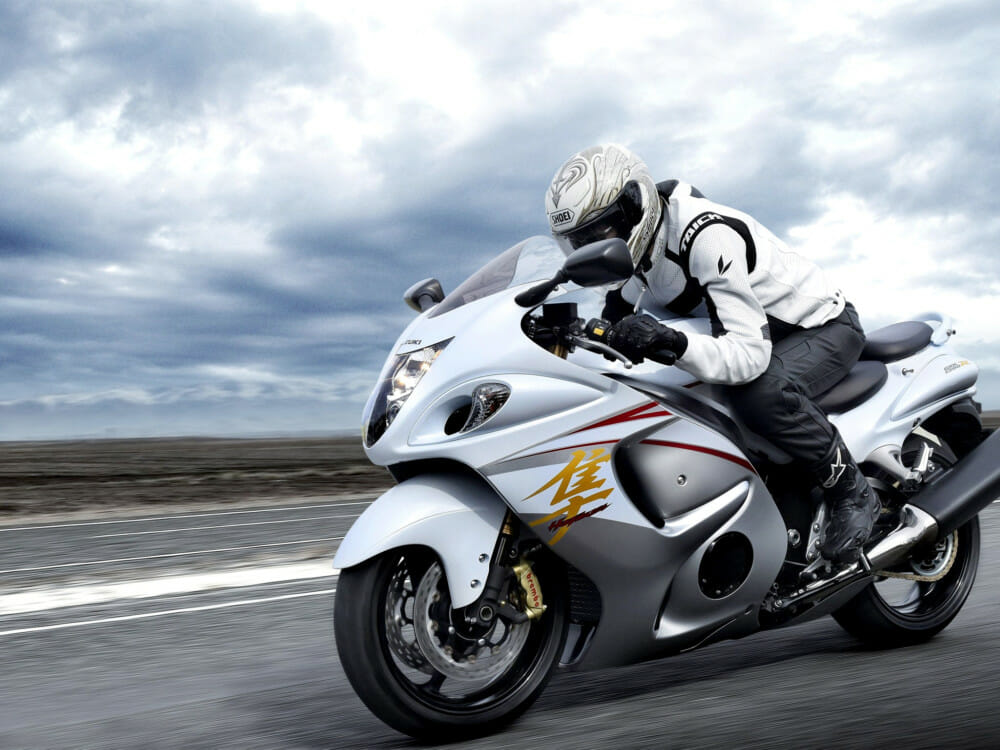 Later-model Hayabusa’s came in a stunning white-and-grey color scheme.
Later-model Hayabusa’s came in a stunning white-and-grey color scheme.
The Hayabusa may have been crowned the King of Speed in perpetuity, but that’s only one facet of its game.
It was designed first and foremost as the world’s fastest touring machine, and this is a title it arguably still has. In the 20 years that have followed since that 1999 debut, Honda euthanized its Super Blackbird in 2006, the same for Kawasaki’s ZX-12R, while they also went the other way—Suzuki’s way—and increased the size of the ZZ-R1100 to 1352cc and called it the ZZ-R1400. Although, it’s arguable if anyone really cared.
What the Suzuki had, more than any horsepower and top-speed advantage, was the name. Like some of the great bikes that came before—Katana, Ninja, Fireblade, Rocket—it was the name that caught people’s attention.
The word Hayabusa is Japanese for the peregrine falcon, the world’s fastest bird, capable of speeds up to 240 mph, and it’s also no small coincidence that the Hayabusa often feasts on smaller birds, like the Japanese Blackbird. What a marketing dream that is.
The amazing thing about the Hayabusa is the fact it has been on sale for two decades and seen only one major update. That happened in 2008 when Suzuki gave the ’Busa a full-blown facelift by punching the capacity out to 1340cc—likely to stave off the challenge from the ZZ-R1400—and gave the motorcycle all-new bodywork and colors, although it still looked very much like the original design from 1999, just sleeker.
And that was it, aside from ABS and some new brake calipers in 2013. No traction-control system is used on a bike that pumps north of 180 horsepower at the wheel, although there are three variable riding modes—you know, in case you want to go slower.
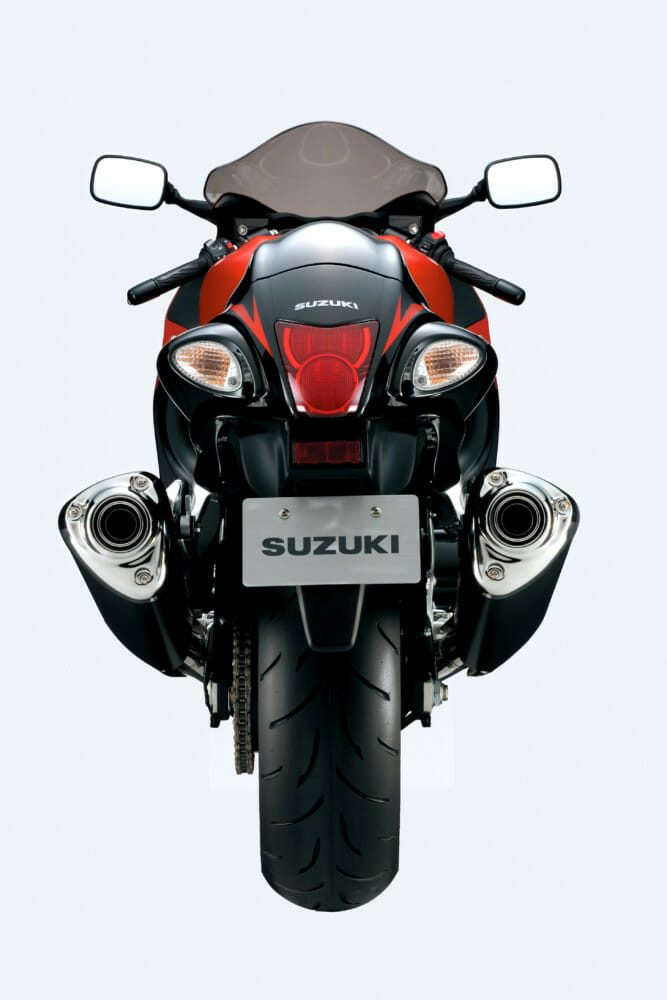 That rear end is unmistakable.
That rear end is unmistakable.
The U.S. is one of the only countries that still have the Suzuki Hayabusa on sale in dealer showrooms, with the 2020 edition going for a very respectable $14,799. As a result of ever more stringent emissions laws, the Hayabusa was forced from Euro showrooms in 2018, although it’s been given a reprieve by the emission lawmakers here in the U.S.
Getting that motor through emissions testing was proving too much of a headache for Suzuki to care anymore. But that’s ironically one of the things that has made the Hayabusa such a legendary machine—how strong, and how tunable, that motor is.
Go to any drag racing event across the country, and you’re bound to find Hayabusas waiting to launch down the strip. That inline four motor is one of the strongest and most horsepower lovin’ lumps of alloy ever to come from Hamamatsu, and it’s not uncommon for a stock bottom end to be able to pump north of 300 horsepower (with a turbo), consistently, without breaking. The ’Busa is a tuner’s delight—it’ll pump out 104 lbs-ft in standard form—and it loves a shot of nitrous or having a great big turbo bolted to it (I rode a 350-horsepower turbo ’Busa in 2008 and let me tell you, it’s every bit as mental as it sounds).
The motor has also proved adept to car racing, with any number of home-brewed Suzuki powered hillclimbers taking the start of the Pikes Peak International Hill Climb, and the motor being used for single-make series like those provided by Radical.
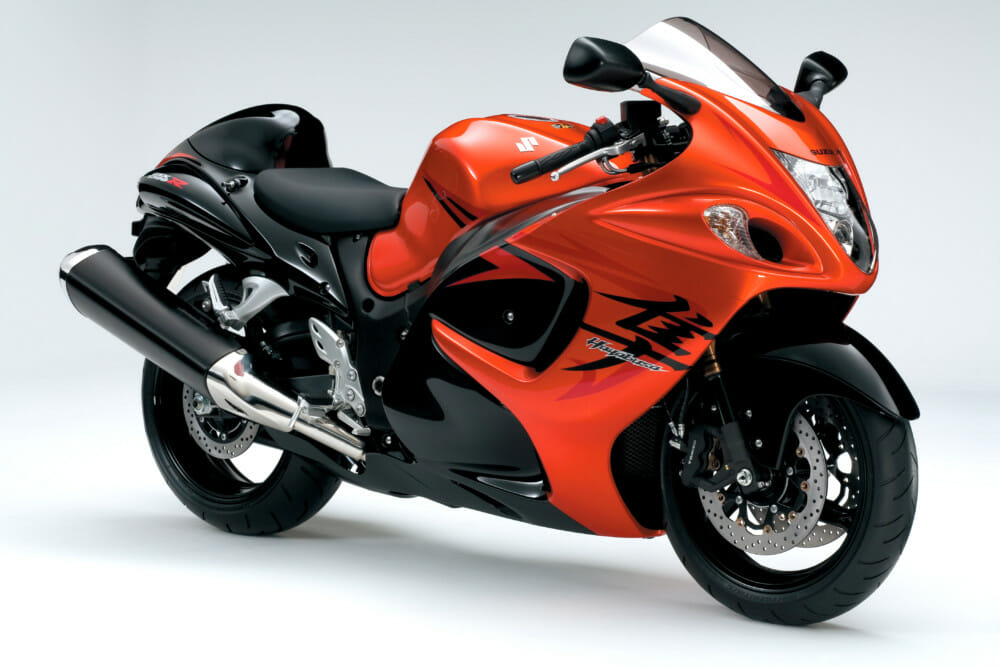 Suzuki has teased a new Hayabusa for years, but even if we don’t get one, it doesn’t take the shine of what a legendary bike the current model is.
Suzuki has teased a new Hayabusa for years, but even if we don’t get one, it doesn’t take the shine of what a legendary bike the current model is.
Aesthetically, the ’Busa is from another time. Put it next to anything from Suzuki’s current lineup, and it looks absolutely out of place, which is probably an endearing quality. It’s fat, low, and funny looking, with a tailpiece that was ripped straight from the 1998 Suzuki RGV500 of Nobuatsu Aoki. Motorcycle design has changed somewhat since then.
But it’s unapologetic in its appearance. You were exactly aware of what bike just passed you simply because, unlike the GSX-R1000, for example, the shape has barely changed in 20 years. It’s as recognizable a Jay Leno.
Suzuki has been teasing the public with a “new” Hayabusa for at least five years now. Much like the turbo Recursion model, we’re unsure if we’ll ever see one. Suzuki’s banked on the Hayabusa for 20 years, and perhaps its time is run, at least until the emissions police finally put the ’Busa on the chopping block.
Be that as it may, there’s no denying the Suzuki Hayabusa’s place in motorcycle history. To call the Hayabusa legendary would be an understatement, especially considering its longevity. The Hayabusa has been around one year longer than Valentino Rossi has been racing 500cc/MotoGP, so that gives you an idea of its endurance.
Happy 20th birthday, Hayabusa.CN
